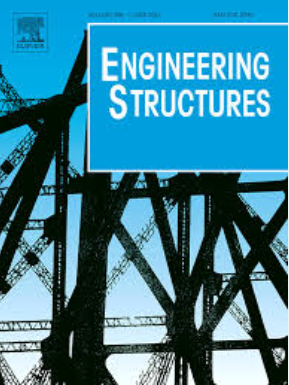Study on flexural performance of stainless steel-timber composite beams with different combination forms
IF 6.4
1区 工程技术
Q1 ENGINEERING, CIVIL
引用次数: 0
Abstract
The combination of steel and timber in different positions is an important design factor for steel and timber composite beams. Stainless steel, characterized by its high strength, ductility, and corrosion resistance, is widely used in construction and civil engineering. To study the flexural performance of stainless steel-timber composite (SSTC) beams with different combination forms of stainless steel bolted connections. Four flange combination and two web combination I-shape section SSTC beams were designed. Four-point bending loading tests were carried out with different flange widths, web heights, and bolt spacings under the two combination forms. Comparative analyses of mechanical characteristics such as damage modes of the specimens, load-deflection curves, combination efficiencies, bending stiffness, and mid-span section strain variation laws were conducted. A finite element model that considered the nonlinearities of stainless steel and timber materials and constructed local geometrical initial defects was established. The findings indicated that the flange SSTC beams demonstrate enhanced ductility and load-carrying capacity when compared to the web SSTC beams, and have better combination effect. The increase in shape section parameters (flange width and web height) effectively increases the flexural stiffness and load carrying capacity of two types of combined beams. The increase in bolt spacing has no significant effect on the load-carrying capacity of the two types of combined beams. An increase in the thickness of timber beams has the effect of enhancing the synergistic ability of combined beams to improve their bending performance. Finally, the bending load capacity calculation method proposed by scholars was evaluated. The calculated values are in good agreement with the experimental and FE values, which can be directly used for calculating bending load capacity of SSTC beams.
不同组合形式不锈钢-木材组合梁抗弯性能研究
钢和木材在不同位置的结合是钢和木材组合梁设计的重要因素。不锈钢具有强度高、延展性好、耐腐蚀等特点,广泛应用于建筑和土木工程中。研究不同不锈钢螺栓连接组合形式下不锈钢-木材组合梁的抗弯性能。设计了4根翼缘组合和2根腹板组合的工字形截面SSTC梁。在两种组合形式下进行了不同法兰宽度、腹板高度和螺栓间距的四点弯曲加载试验。对比分析了试件的损伤模式、荷载-挠度曲线、组合效率、抗弯刚度、跨中截面应变变化规律等力学特性。建立了考虑不锈钢和木材材料非线性特性,构造局部几何初始缺陷的有限元模型。结果表明:与腹板SSTC梁相比,翼缘SSTC梁的延性和承载能力有所提高,组合效果更好;形状截面参数(翼缘宽度和腹板高度)的增加有效地提高了两种组合梁的抗弯刚度和承载能力。锚杆间距的增加对两种组合梁的承载力影响不显著。增加木梁的厚度可以增强组合梁的协同能力,从而改善组合梁的抗弯性能。最后对学者提出的弯曲承载力计算方法进行了评价。计算值与试验值和有限元值吻合较好,可直接用于SSTC梁的弯曲承载能力计算。
本文章由计算机程序翻译,如有差异,请以英文原文为准。
求助全文
约1分钟内获得全文
求助全文
来源期刊

Engineering Structures
工程技术-工程:土木
CiteScore
10.20
自引率
14.50%
发文量
1385
审稿时长
67 days
期刊介绍:
Engineering Structures provides a forum for a broad blend of scientific and technical papers to reflect the evolving needs of the structural engineering and structural mechanics communities. Particularly welcome are contributions dealing with applications of structural engineering and mechanics principles in all areas of technology. The journal aspires to a broad and integrated coverage of the effects of dynamic loadings and of the modelling techniques whereby the structural response to these loadings may be computed.
The scope of Engineering Structures encompasses, but is not restricted to, the following areas: infrastructure engineering; earthquake engineering; structure-fluid-soil interaction; wind engineering; fire engineering; blast engineering; structural reliability/stability; life assessment/integrity; structural health monitoring; multi-hazard engineering; structural dynamics; optimization; expert systems; experimental modelling; performance-based design; multiscale analysis; value engineering.
Topics of interest include: tall buildings; innovative structures; environmentally responsive structures; bridges; stadiums; commercial and public buildings; transmission towers; television and telecommunication masts; foldable structures; cooling towers; plates and shells; suspension structures; protective structures; smart structures; nuclear reactors; dams; pressure vessels; pipelines; tunnels.
Engineering Structures also publishes review articles, short communications and discussions, book reviews, and a diary on international events related to any aspect of structural engineering.
 求助内容:
求助内容: 应助结果提醒方式:
应助结果提醒方式:


